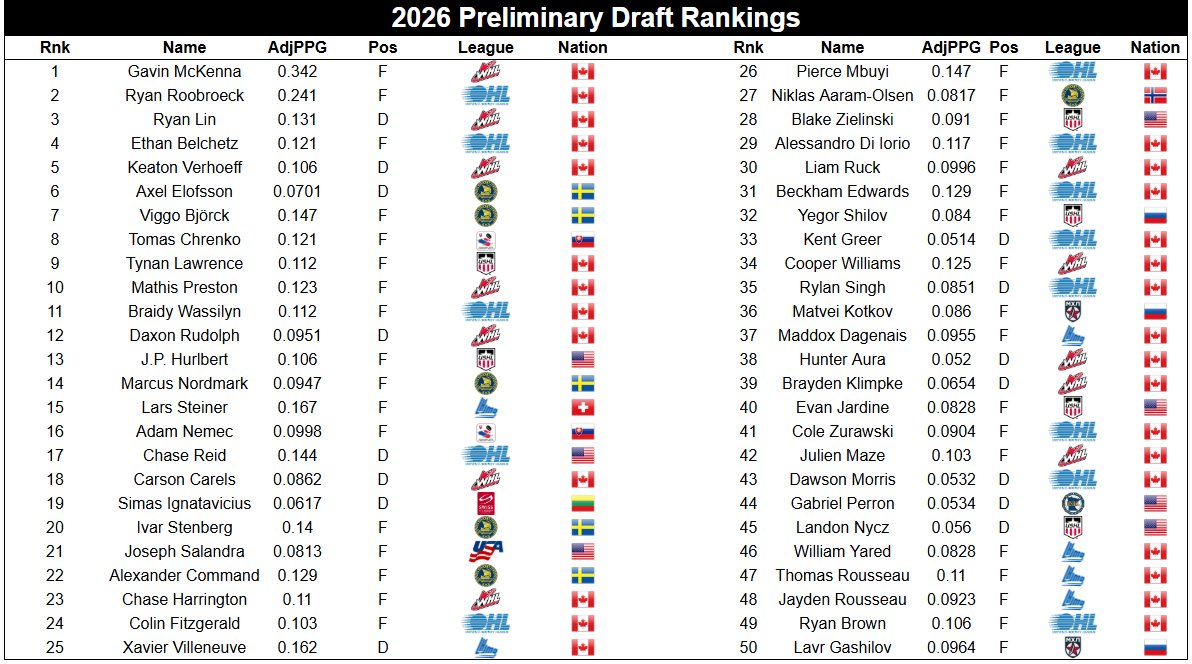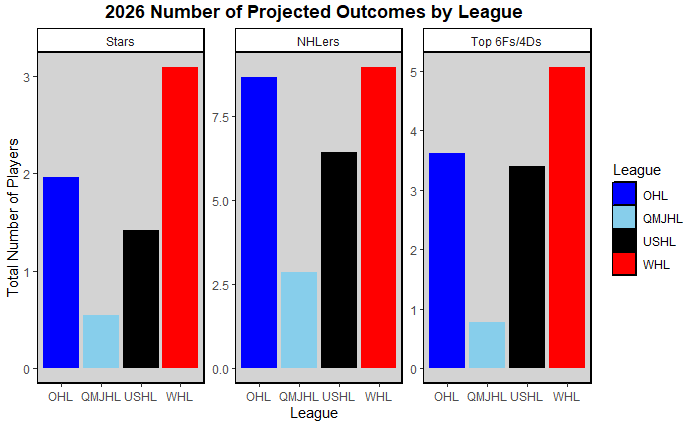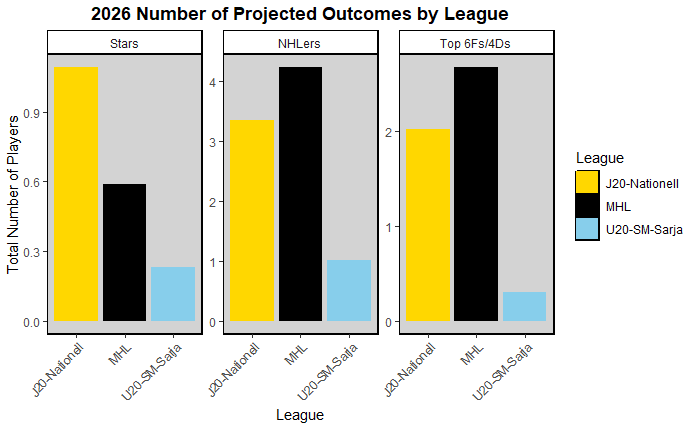Overview
To wrap up my draft coverage (for now) I wanted to take a look at who the potential top players in the 2026 class are. I obviously don't know as much about this class, so I can't sit here and say this player does this well, or this poorly and that's why they're ranked higher or lower in the model compared to expectations. Also I wouldn't really trust anybody who is giving strong opinions on any players in this class the day after the 2025 draft ended. Unless you were specifically following this class all of last year and not the 2025 class, I refuse to belive that you could have super strong opinions on both. I'm not saying my model is the greatest DY-1 ranking ever, but I would say it would be a good place to start looking at players from. I also wouldn't say there are really any "good" DY-1 rankings. Players will grow and develop and stangnate throughout the year. Trajectory is not linear and while we can use the DY-1 as a prior, I would never use it to form my whole opinion on a player. We also know that historically DY-1 scoring has not been as predictive as DY scoring for future success, especially for defensemen. Though I wonder how much of the correlation between DY scoring and future success is cofounded by being a high pick. Scoring more -> higher pick -> getting more development attention/opportunities -> more success. Are players who score the same but are picked in different rounds equally likely to have success.
While I changed the model up slightly for this project, and used DY-1 scoring as the predictor instead of DY scoring obviously, the model remained largely similar to my 2025 draft model. I took the time to tweak the model, and run a few extra steps when training with 5 fold cross validation, and test to see how removing or adding small other predictors, like height and weight would change it. I also generally feel iffy using height and weight for prospect models, especially DY-1 models though, because these guys are FAR from fully developed physically. Most of the training data I have is current heights and weights of players who are 20-40 years old and fully developed physically. Then the data for the rankings is from junior teams, or sometimes even less reliable sources from when they were 16 or younger. Obviously those kids can put on 10-20+ lbs before they make the NHL which could wildly skew how well the model views them. However it is also hard to predict how well these kids can put on muscle, we don't know what their muscle insertions are like, how well they respond to physical training, or what they've been doing for the past few years in terms of S&C, and all of those factors can play a role in how much mass these kids can put on to hold up to the men in the NHL.
I also wanted to look at what leagues were looking to have strong classes a year out from the draft. I wouldn't read too much into this as these things can change obviously, but maybe if you're a one man scouting army, focus on the leagues with more projected players first. And if you're a regional scout from one region, you may have more fun than a regional scout from another this year.
Results
I just shared the top 50 preseason rankings because after that, and really even including a lot of these are so incredibly random. Really after the top few players it is just a big watch list of who I think could be interesting to track throughout the year, but the list is here:

I can't say I know much about a ton of these players, but obviously McKenna at 1 is the easiest ranking I've had in years. I think Roobroeck is the clear 2 right now, I don't trust DY-1 evaluations for d men, like Verhoeff, but I also think Roobroeck is incredibly underrated. He's older for the class but has had 2 great years in the OHL already, has a great blend of size and skill and skating, and came into the OHL with good hype, going second only behind 2025 NHL draft 1OA pick Matthew Schaefer. He also had the 8th highest DY-1 OHL scoring season this quarter century, which you do hope to see from a top 3 pick who's older for the class, but is a good sign nonetheless. Obviously Lin over Verhoeff is bold, I don't think the NHL would ever choose the 5'11 high scoring d man over the 6'4 high scoring d man, but we'll see how Verhoeff adjusts to the NCAA this year, and he could easily end up at 2OA in the model with a big season for NoDak. Axel Elofsson shocked me being the high intially, then he had a great Hlinka and I felt somewhat justified, so we'll see how he pans out for the rest of the year. I really really liked Tynan Lawrence in Muskegon last year, think he was better than Ryabkin a lot of nights, and JP Hurlbert has been the top American in this class for years (and a very respectable kid too). Also shoutout to Simas Ignatavicius who will almost certainly be the first Lithuanian selected since Dainius Zubris in 1996. Then even behind McKenna, this class of 08s (and 09s next year) in the W is special, I love the Ruck twins and Mathis Preston. Daxon Rudolph and Hunter Aura, while maybe not being top 5 players in the class like their names, are both legitimate NHL prospects as well. Then Xavier Villeneuve is another short, but high skilled offensive defenseman, this time out of the Q. The risks there are obvious, but he has about as much upside as almost anyone else in this class.


The last thing I did was look at the strength of the draft classes as a whole. The Q may have a few top players with Steiner and Villeneuve, but it doesn't have the depth again and is will likely have the weakest class of the 4 North American leagues (again). The USHL is also probably a pretty weak class because the top American in Hurlbert has ledt to the dub, which will probably be the strongest league this year, even after losing Verhoeff and McKenna to the NCAA, though the OHL has a consistent level of solid depth players, as usual. Then for Europe, while Russia may not have the star power of some of their previous year, or what Sweden has this year, they should have a very solid, deep class. It will hopefully not make Dylan Griffing want to pull his hair out as much as the 2025 class did, and at least be able to get him to the more fun looking 2027 class (Though I don't understand how someone can willingly watch MHL hockey almost every day for years and still be sane in the first place). Then for Finland, it is looking like yet another weak year for the Finns, no players in the top 50, and only ~1 projected NHLer.
Data
All of my data came from EliteProspects. The points, the leagues, the heights and weights, all of it. I then spent a lot of time cleaning that data and building the models, but all of the data initially came from EP.